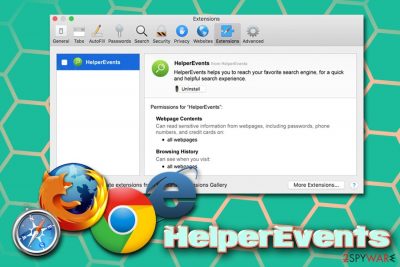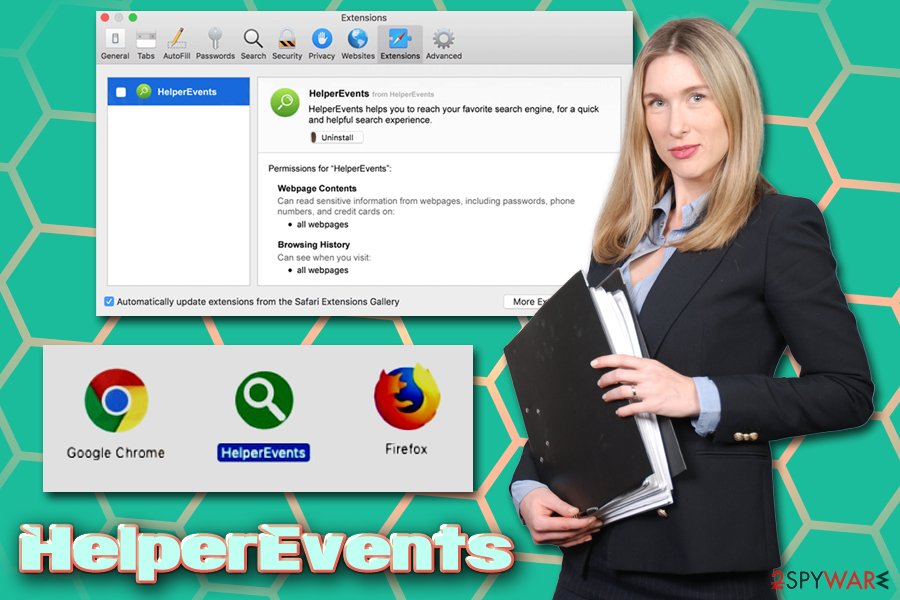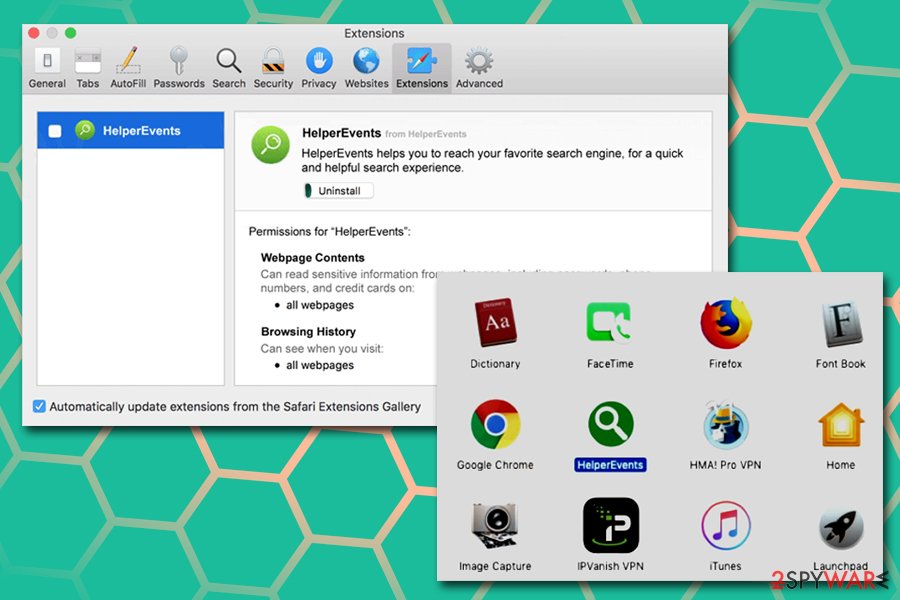HelperEvents (Virus Removal Guide) - Free Instructions
HelperEvents Removal Guide
What is HelperEvents?
HelperEvents is an adware application that might compromise your Mac security

HelperEvents is a potentially dangerous adware[1] application designed for macOS systems. The extension hijacks Google Chrome, Safari, Mozilla Firefox, or another browser and connects to an unknown server before displaying search results. However, most of the users might not even notice the changes, because they are immediately redirected to Google.
Nevertheless, the search results that HelperEvents shows are far from organic,[2] and users will quickly notice numerous sponsored links at the top, which are marked as “Ad.” These links can lead users to questionable, scam, or even malware-laden websites. What is more, the HelperEvents is capable of reading sensitive information (passwords, phone numbers, and even credit cards) due to permissions that were granted during its installation, which, in most cases, also happens behind users' backs.
Therefore, if you notice that your browser is often taking you to suspicious domains and ads cover your screen on all sites that you visit, you should check for and remove HelperEvents virus from your Mac as soon as possible.
| Name | HelperEvents |
| Type | Adware |
| Targeted system | macOS, Mac OS X |
| Danger level | Medium. Can read sensitive data on websites users visit |
| Infiltration | Software bundles, third-party sites |
| Symptoms | Increased amount of pop-up and other type of ads on all sites, redirects, sponsored links, etc. |
| Termination & recovery | Check out our manual removal options below; if you struggle to eliminate HelperEvents PUP, you can employ FortectIntego or another security software that would get rid of the threat automatically |
In most of the cases, adware is a relatively harmless piece of software that displays ads as a way to monetize on software that it offers for free. It would be all good, apart from most of the ad-supported applications that are offered are completely useless, and can also compromise one's online safety and computer security. Unfortunately, HelperEvents is one of those apps.
Generally speaking, Mac is also considered a more secure operating system in comparison to Windows. Nevertheless, the number of adware apps spiked for this OS significantly for the past years, as scareware[3] apps like Advanced Mac Cleaner, Mac Tweaker, Mac Tonic, and others flooded users' machines. The fake Flash updates also showed up and installed such threats as Shlayer Trojan, which is capable of downloading and installing malicious apps automatically.
For that reason, if you found an unrecognizable application like HelperEvents on your computer, you should be concerned whether it is not infected with more sinister threats. Nevertheless, it might also be the case that you downloaded freeware from third-party sites and did not pay attention to the installation process carefully.

The worst part about HelperEvents infection is that it reads sensitive data from your browsers and might send them to unknown parties (potentially criminals). The permission section of the app states:
Webpage Contents
Can read sensitive information from webpages, including passwords, phone numbers, and credit cards on:
- all webpages
If you noticed suspicious browser activity like redirects, or an excessive amount of pop-ups, in-text links, deals, offers, coupons, and other commercial content, you should scan your computer with FortectIntego or another reputable security software to locate and remove HelperEvents along with other PUPs automatically.
Nevertheless, you can also try to terminate HelperEvents with the help of our manual guide below – you will also find how to reset each of the affected browsers, including Google Chrome, Mozilla Firefox, Safari, Internet Explorer, and others.
Be careful when installing free application from third-party sites
Potentially unwanted programs are called so for a reason – namely because they usually enter computers without user consent. There is hardly a website that does not offer installers with additional components embedded into them – it is simply a way that they monetize. Unfortunately, some of these offered applications might not only be “unwanted” but also potentially dangerous. For example, it is redirecting to suspicious websites or harvesting sensitive information such as credit card details.
Therefore, it is crucial to pay attention to the installation process of free programs. Here's what you should be concerned about when dealing with unknown installers:
- Make sure the application comes from a somewhat known website (such as download.com, filehippo.com, and similar) and avoid shady sites that host pirated software;
- Before installing, check that the app provides the documents required for all legitimate programs – Privacy Policy, Terms of Service/EULA;
- Beware of various tricks: pre-selected boxes, fine print text, deceptive deals, misleading button placements, etc.;
- When prompted, select Advanced/Custom installation settings instead of Recommended/Custom ones, as it is sometimes the only way to disclose the full list of suggested applications.
- As a general rule, always have updated security software running on your machine.

Get rid of HelperEvents to avoid sensitive information leak to unknown parties
As we previously stated, HelperEvents virus can read the very sensitive information from your browsers, such as credit card details. The question is, why would an app that is used to allegedly enhance web browsing experience would need this functionality? These type of features are extremely dangerous and have disastrous ramifications. Thus, you should not delay HelperEvents removal, otherwise, you might face money loss, or even identity theft, along with painful web browsing experience.
To remove HelperEvents, you should either scan your computer with reputable anti-malware software – it will be able to uninstall all the components of the PUP, along with entries that the app put to your device. If you want to try eliminating the unwanted app manually, you should check our guide below. Nevertheless, before you do that, you should check the following folders for suspicious HelperEvents entries:
- /Library/LaunchAgents
- /Library/Application Support
- /Library/LaunchDaemons
After you delete the unwanted components, make sure you reset each of the installed browsers as well.
You may remove virus damage with a help of FortectIntego. SpyHunter 5Combo Cleaner and Malwarebytes are recommended to detect potentially unwanted programs and viruses with all their files and registry entries that are related to them.
Getting rid of HelperEvents. Follow these steps
Delete from macOS
To remove HelperEvents from your Mac, you should enter the installed application folder and drag the unwanted app to trash:
Remove items from Applications folder:
- From the menu bar, select Go > Applications.
- In the Applications folder, look for all related entries.
- Click on the app and drag it to Trash (or right-click and pick Move to Trash)

To fully remove an unwanted app, you need to access Application Support, LaunchAgents, and LaunchDaemons folders and delete relevant files:
- Select Go > Go to Folder.
- Enter /Library/Application Support and click Go or press Enter.
- In the Application Support folder, look for any dubious entries and then delete them.
- Now enter /Library/LaunchAgents and /Library/LaunchDaemons folders the same way and terminate all the related .plist files.

Remove from Microsoft Edge
Delete unwanted extensions from MS Edge:
- Select Menu (three horizontal dots at the top-right of the browser window) and pick Extensions.
- From the list, pick the extension and click on the Gear icon.
- Click on Uninstall at the bottom.

Clear cookies and other browser data:
- Click on the Menu (three horizontal dots at the top-right of the browser window) and select Privacy & security.
- Under Clear browsing data, pick Choose what to clear.
- Select everything (apart from passwords, although you might want to include Media licenses as well, if applicable) and click on Clear.

Restore new tab and homepage settings:
- Click the menu icon and choose Settings.
- Then find On startup section.
- Click Disable if you found any suspicious domain.
Reset MS Edge if the above steps did not work:
- Press on Ctrl + Shift + Esc to open Task Manager.
- Click on More details arrow at the bottom of the window.
- Select Details tab.
- Now scroll down and locate every entry with Microsoft Edge name in it. Right-click on each of them and select End Task to stop MS Edge from running.

If this solution failed to help you, you need to use an advanced Edge reset method. Note that you need to backup your data before proceeding.
- Find the following folder on your computer: C:\\Users\\%username%\\AppData\\Local\\Packages\\Microsoft.MicrosoftEdge_8wekyb3d8bbwe.
- Press Ctrl + A on your keyboard to select all folders.
- Right-click on them and pick Delete

- Now right-click on the Start button and pick Windows PowerShell (Admin).
- When the new window opens, copy and paste the following command, and then press Enter:
Get-AppXPackage -AllUsers -Name Microsoft.MicrosoftEdge | Foreach {Add-AppxPackage -DisableDevelopmentMode -Register “$($_.InstallLocation)\\AppXManifest.xml” -Verbose

Instructions for Chromium-based Edge
Delete extensions from MS Edge (Chromium):
- Open Edge and click select Settings > Extensions.
- Delete unwanted extensions by clicking Remove.

Clear cache and site data:
- Click on Menu and go to Settings.
- Select Privacy, search and services.
- Under Clear browsing data, pick Choose what to clear.
- Under Time range, pick All time.
- Select Clear now.

Reset Chromium-based MS Edge:
- Click on Menu and select Settings.
- On the left side, pick Reset settings.
- Select Restore settings to their default values.
- Confirm with Reset.

Remove from Mozilla Firefox (FF)
Mozilla Firefox can stay hijacked by the PUP, even after its removal. This is due to settings change. To revert these, please follow these steps:
Remove dangerous extensions:
- Open Mozilla Firefox browser and click on the Menu (three horizontal lines at the top-right of the window).
- Select Add-ons.
- In here, select unwanted plugin and click Remove.

Reset the homepage:
- Click three horizontal lines at the top right corner to open the menu.
- Choose Options.
- Under Home options, enter your preferred site that will open every time you newly open the Mozilla Firefox.
Clear cookies and site data:
- Click Menu and pick Settings.
- Go to Privacy & Security section.
- Scroll down to locate Cookies and Site Data.
- Click on Clear Data…
- Select Cookies and Site Data, as well as Cached Web Content and press Clear.

Reset Mozilla Firefox
If clearing the browser as explained above did not help, reset Mozilla Firefox:
- Open Mozilla Firefox browser and click the Menu.
- Go to Help and then choose Troubleshooting Information.

- Under Give Firefox a tune up section, click on Refresh Firefox…
- Once the pop-up shows up, confirm the action by pressing on Refresh Firefox.

Remove from Google Chrome
Google Chrome is the most popular browser, so many potentially unwanted programs are crafted for the browser. Reset it after the infection of adware:
Delete malicious extensions from Google Chrome:
- Open Google Chrome, click on the Menu (three vertical dots at the top-right corner) and select More tools > Extensions.
- In the newly opened window, you will see all the installed extensions. Uninstall all the suspicious plugins that might be related to the unwanted program by clicking Remove.

Clear cache and web data from Chrome:
- Click on Menu and pick Settings.
- Under Privacy and security, select Clear browsing data.
- Select Browsing history, Cookies and other site data, as well as Cached images and files.
- Click Clear data.

Change your homepage:
- Click menu and choose Settings.
- Look for a suspicious site in the On startup section.
- Click on Open a specific or set of pages and click on three dots to find the Remove option.
Reset Google Chrome:
If the previous methods did not help you, reset Google Chrome to eliminate all the unwanted components:
- Click on Menu and select Settings.
- In the Settings, scroll down and click Advanced.
- Scroll down and locate Reset and clean up section.
- Now click Restore settings to their original defaults.
- Confirm with Reset settings.

Delete from Safari
Remove unwanted extensions from Safari:
- Click Safari > Preferences…
- In the new window, pick Extensions.
- Select the unwanted extension and select Uninstall.

Clear cookies and other website data from Safari:
- Click Safari > Clear History…
- From the drop-down menu under Clear, pick all history.
- Confirm with Clear History.

Reset Safari if the above-mentioned steps did not help you:
- Click Safari > Preferences…
- Go to Advanced tab.
- Tick the Show Develop menu in menu bar.
- From the menu bar, click Develop, and then select Empty Caches.

After uninstalling this potentially unwanted program (PUP) and fixing each of your web browsers, we recommend you to scan your PC system with a reputable anti-spyware. This will help you to get rid of HelperEvents registry traces and will also identify related parasites or possible malware infections on your computer. For that you can use our top-rated malware remover: FortectIntego, SpyHunter 5Combo Cleaner or Malwarebytes.
How to prevent from getting adware
Access your website securely from any location
When you work on the domain, site, blog, or different project that requires constant management, content creation, or coding, you may need to connect to the server and content management service more often. The best solution for creating a tighter network could be a dedicated/fixed IP address.
If you make your IP address static and set to your device, you can connect to the CMS from any location and do not create any additional issues for the server or network manager that needs to monitor connections and activities. VPN software providers like Private Internet Access can help you with such settings and offer the option to control the online reputation and manage projects easily from any part of the world.
Recover files after data-affecting malware attacks
While much of the data can be accidentally deleted due to various reasons, malware is one of the main culprits that can cause loss of pictures, documents, videos, and other important files. More serious malware infections lead to significant data loss when your documents, system files, and images get encrypted. In particular, ransomware is is a type of malware that focuses on such functions, so your files become useless without an ability to access them.
Even though there is little to no possibility to recover after file-locking threats, some applications have features for data recovery in the system. In some cases, Data Recovery Pro can also help to recover at least some portion of your data after data-locking virus infection or general cyber infection.




















